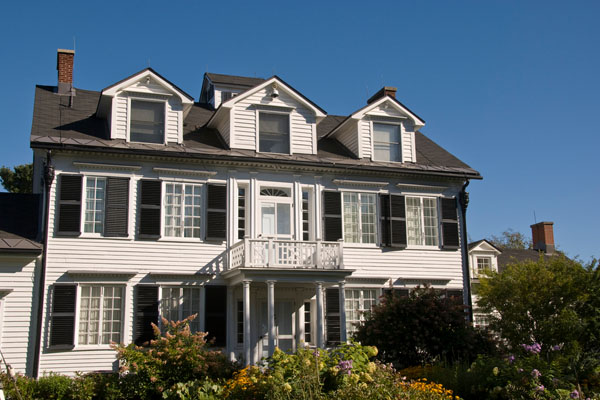 Historic homes aren’t typically built to accommodate most air conditioner makes and models. Although a lot of older houses are well-looked-after, these structures often have a layout that makes it challenging to determine the best cooling system. Historic homes aren't fitted with a network of ducts as well. If you want to accommodate ductwork into the historic home, then that means you have to tear down walls and ceilings then rebuild them back up again. This is a significant construction project that could affect the preservation of the historic home. Out of all the HVAC systems on the market, a ductless air conditioning system is the most viable solution. This system will help you preserve your historic home as well as make sure that you and your family are comfortable in an energy-efficient manner. [maxbutton id="4" text="Explore Our Ductless HVAC Installations" ] [maxbutton id="11" text="Call Today For A Free Consultation" ]
Historic homes aren’t typically built to accommodate most air conditioner makes and models. Although a lot of older houses are well-looked-after, these structures often have a layout that makes it challenging to determine the best cooling system. Historic homes aren't fitted with a network of ducts as well. If you want to accommodate ductwork into the historic home, then that means you have to tear down walls and ceilings then rebuild them back up again. This is a significant construction project that could affect the preservation of the historic home. Out of all the HVAC systems on the market, a ductless air conditioning system is the most viable solution. This system will help you preserve your historic home as well as make sure that you and your family are comfortable in an energy-efficient manner. [maxbutton id="4" text="Explore Our Ductless HVAC Installations" ] [maxbutton id="11" text="Call Today For A Free Consultation" ]
What Are Ductless Mini-Split Systems?
Advantages Of Ductless Air Conditioners
Ductless mini-splits offer a lot of benefits. This is why it is the go-to cooling solution of most historic homes. Some of these pros are as follows:Ductless HVAC Offers Ease Of Installation
 Unlike ducted HVAC systems, ductless mini-splits do not require a major reconstruction project for installation. For example, to install a central air conditioning system in a home that does not have ductwork, the walls and ceiling of your home will need to be torn down. Likewise, they will have to be rebuilt once the installation takes place. However, the installation of a ductless mini-split only needs a small hole drilled on an exterior wall. This makes ductless systems some of the easiest HVAC units to install.
Unlike ducted HVAC systems, ductless mini-splits do not require a major reconstruction project for installation. For example, to install a central air conditioning system in a home that does not have ductwork, the walls and ceiling of your home will need to be torn down. Likewise, they will have to be rebuilt once the installation takes place. However, the installation of a ductless mini-split only needs a small hole drilled on an exterior wall. This makes ductless systems some of the easiest HVAC units to install.
Energy Efficiency
An estimated 25 percent of energy is lost via the ductwork in a traditional HVAC system. Also, window air conditioners do not operate efficiently and are costly to operate. All of these issues are avoidable when you install a ductless unit. Ductless systems have high SEER ratings. Also, with a ductless system in place, you will have access to inverter technology. This means that it has a variable-speed compressor that automatically adjusts its speed depending on the temperature in the zone. A traditional unit has a compressor that repeatedly turns on and off to maintain the set temperature. More energy is consumed this way, so you save more when you have a ductless system. You can also switch off the indoor air handlers in empty rooms, unlike in central units. This allows you to save money as you do not need to condition an unoccupied space. [maxbutton id="11" ]Experience Cost-Savings With Ductless Mini-Split Systems
 The high-efficiency ratings of most ductless systems mean that you are saving on energy costs. Operating costs vary from the model and size. However, ductless AC units allow you to only cool occupied rooms while turning off the units on areas that have no people in it. As mentioned above, many ductless makes and models also have high SEER ratings. Therefore, you spend less when it comes to the energy consumed.
The high-efficiency ratings of most ductless systems mean that you are saving on energy costs. Operating costs vary from the model and size. However, ductless AC units allow you to only cool occupied rooms while turning off the units on areas that have no people in it. As mentioned above, many ductless makes and models also have high SEER ratings. Therefore, you spend less when it comes to the energy consumed.
Improved Indoor Air Quality
Ductwork is notorious for accumulating lint, dirt, animal dander, and other indoor air contaminants. These pollutants are released to your home via the air supply vents. Window ACs, likewise, tend to create an environment that is conducive to mold and bacteria growth. All of these issues affect your indoor air quality. However, you don't have to worry about these problems with a ductless air conditioner in place. Ductless mini-splits have advanced air filters to help improve the quality of the air you breathe. [maxbutton id="4" text="Learn More About Mitsubishi Ductless Mini-Splits" ] [maxbutton id="11" text="Call For A Free, In-Home Estimate" ]Creation Of Heating & Cooling Zones
Ductless mini-split setups allow the creation of zones. You can place an indoor air handler in each zone, allowing you to customize comfort. For instance, you can have a warm bedroom but set a lower temperature in your kitchen. Zoning allows you to personalize comfort so everyone in your family can enjoy an indoor living environment according to their individual preferences.Ductless Features Whisper-Quiet Operation
The indoor units of ductless HVAC systems are equipped with small tubes where conditioned air passes through before they are released via air vents. This ensures that your ductless unit operates at a whisper-quiet level. This is unlike ducted systems that use large ducts to circulate cold air. The same goes for window air conditioning systems that work loudly due to the lack of insulation. Its noisy operation is also because all of its parts are compressed into one unit. As a result, they are louder than ductless units.Less Burden On The Environment
Aside from consuming less energy than window cooling equipment or its conventional HVAC counterparts, ductless systems use an environmentally-friendly refrigerant. This way, you receive a high-level of comfort without compromising the environment. Also, since they use less energy, they are more environmentally friendly. [maxbutton id="11" text="Call Lawes Company Today: (732) 741-6300" ]Will A Ductless A/C Affect The Structure Of A Historic Home?
The most beneficial feature of a ductless air conditioner for a historic home is it does not need ductwork to function at peak capacity. It does not require any invasive and often costly construction. You do not need to acquire special permits to tear down and rebuild the walls and ceiling. A three-inch hole that the expert HVAC installer drills through the wall is all you need to accommodate a ductless system. This small hole is where the conduit will pass through to connect the indoor unit with the outdoor compressor. The historic home won’t sustain any other damage aside from this small hole. Not only that, but a ductless cooling system also has a compact design that doesn’t need a lot of space.Can I Use A Window AC As An Alternative To A Ductless System?
Window air conditioners might look like a good alternative to a ductless AC. However, it is far from it. A giant hole on the wall or a window space is needed to fit a window-type AC. This large hole will only make it easier for bugs and even burglars to go inside your home. This type of AC unit also blocks natural light, operates noisily, and creates an environment for bacteria, mildew, and mold growth. You will also need to remove and store this heavy unit when winter comes.Conclusion
 To maintain a historic home means you preserve its aesthetic value. Cooling a historic home might seem like a challenging task. However, it is possible with the help of ductless cooling systems. This type of HVAC unit is able to effectively and efficiently cool your historic home. It also retains the value, beauty, and history that your historic home has. If you are looking to install a ductless mini-split to your home, get in touch with your trusted local HVAC technician today.
To maintain a historic home means you preserve its aesthetic value. Cooling a historic home might seem like a challenging task. However, it is possible with the help of ductless cooling systems. This type of HVAC unit is able to effectively and efficiently cool your historic home. It also retains the value, beauty, and history that your historic home has. If you are looking to install a ductless mini-split to your home, get in touch with your trusted local HVAC technician today.
Call Lawes Company To Learn More About Ductless HVAC Systems
 When you require top-notch HVAC services in the area, get in touch with Lawes Company. Each of our techs is licensed, and NATE certified to conduct services such as mini-split installations, central HVAC system tune-ups, boiler repairs, and more. Our experts are equipped with the proper tools, extensive knowledge, and years of experience to ensure that all services are done correctly and quickly. Lawes Company offers the most competitive HVAC services in the area. We guarantee that we can provide you with the best solutions for all your HVAC needs while staying within your budget. As always, your comfort, energy efficiency, and indoor air quality are our top priorities. To schedule an appointment, give Lawes Company a call today for a free, in-home estimate. [maxbutton id="5" ] Contact us now at (732) 741-6300 to find out more!
When you require top-notch HVAC services in the area, get in touch with Lawes Company. Each of our techs is licensed, and NATE certified to conduct services such as mini-split installations, central HVAC system tune-ups, boiler repairs, and more. Our experts are equipped with the proper tools, extensive knowledge, and years of experience to ensure that all services are done correctly and quickly. Lawes Company offers the most competitive HVAC services in the area. We guarantee that we can provide you with the best solutions for all your HVAC needs while staying within your budget. As always, your comfort, energy efficiency, and indoor air quality are our top priorities. To schedule an appointment, give Lawes Company a call today for a free, in-home estimate. [maxbutton id="5" ] Contact us now at (732) 741-6300 to find out more! from Lawes Company - Feed https://www.lawescompany.com/ductless-air-conditioning/
